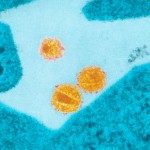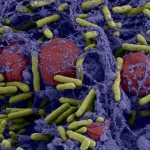Lien vers Pubmed [PMID] – 12431990
J. Biol. Chem. 2003 Jan;278(5):3153-61
The contribution of raft domains to human immunodeficiency virus (HIV) 1 entry was assessed. In particular, we asked whether the CD4 and CCR5 HIV-1 receptors need to associate with sphingolipid-enriched, detergent-resistant membrane domains (rafts) to allow viral entry into primary and T-cell lines. Based on Triton X-100 solubilization and confocal microscopy, CD4 was shown to distribute partially to rafts. In contrast, CCR5 did not associate with rafts and localized in nonraft plasma membrane domains. HIV-1-receptor partitioning remained unchanged upon viral adsorption, suggesting that viral entry probably takes place outside rafts. To directly investigate this possibility, we targeted CD4 to nonraft domains of the membrane by preventing CD4 palmitoylation and interaction with p56(lck). Directed mutagenesis of both targeting signals significantly prevented association of CD4 with rafts, but did not suppress the HIV-1 receptor function of CD4. Collectively, these results strongly suggest that the presence of HIV-1 receptors in rafts is not required for viral infection. We show, however, that depleting plasma membrane cholesterol inhibits HIV-1 entry. We therefore propose that cholesterol modulates the HIV-1 entry process independently of its ability to promote raft formation.




